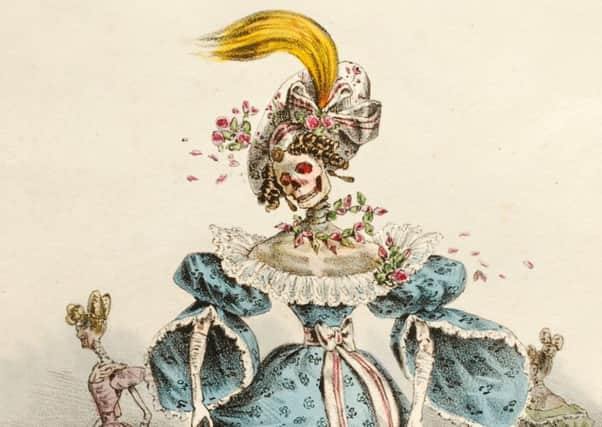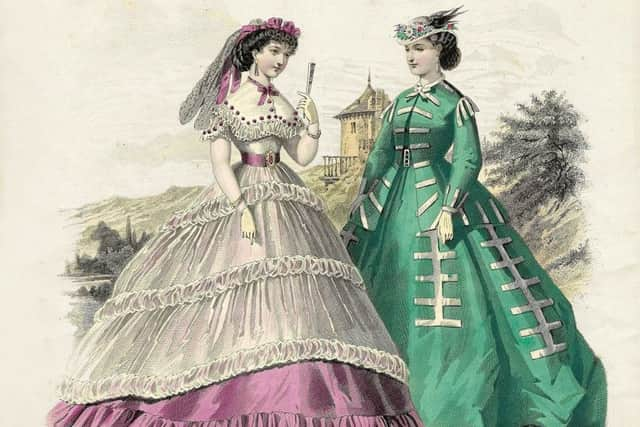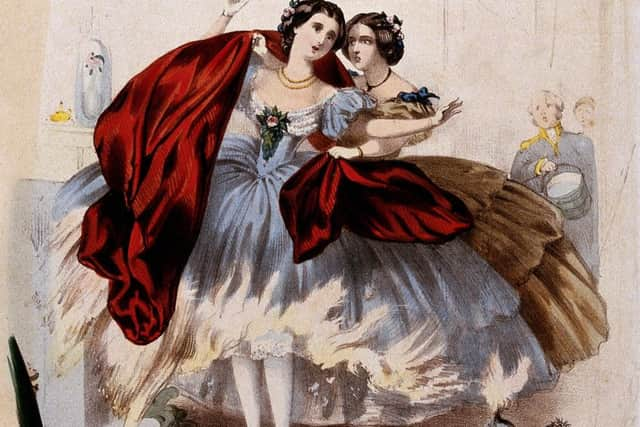Fashion Victims, the book exposing the industry’s deadly history


WE ALL love a pair of killer heels. But toxic socks, flaming flannelette pyjamas, sand-blasted jeans? These are just some examples of downright dangerous clothing that have led to serious injury and death as the fatal attraction of fashion lays claim to countless victims down a long and gory history.
In her brilliantly illustrated and fascinating book, Fashion Victims: The Dangers Of Dress Past And Present, Alison Matthews David lifts the lid on the clothes that have damaged the health of those who both made and wore them, focusing in particular on the 19th and early 20th centuries in France, the UK and North America, where putting fashion ahead of health led to death, disease and madness. She also brings it right up to date.
Advertisement
Hide AdAdvertisement
Hide Ad“We all wear clothes, not just an elite, so everyone can relate to this. We have all encountered health-related incidents in fashion and hopefully we’re all becoming more aware of how things are made,” she says.


Emerald green was suddenly all the rage for fashionable women in the 19th century after it became possible to produce a vivid colour that put the previous wishy-washy tones available in the shade. The key ingredient was arsenic, and people couldn’t get enough of it. From cloth for dresses and brushed on to trimming for hats, it was everywhere.
“Green wasn’t a colour that was easy to dye,” says Matthews David, “but arsenic didn’t fade and looked bright under lights. It was stunning and became hugely popular in clothes. A ball gown would contain enough arsenic to kill 200 people and a hair wreath 50. The amounts used were lethal. It was used in wallpaper and food colour too and there were reports of people in Glasgow being poisoned by the icing on cakes.”
For those making the dresses and accessories, the effects were deadly, with the vulnerable girls developing ulcers and cancers.
In 1861, Matilda Scheurer, a 19-year-old artificial flower maker in London, died of “accidental” poisoning, the result of her job dusting artificial leaves with a green pigment made from arsenic powder. All day Scheurer inhaled the dust and ate off her hands at mealtimes.


More shocking than her death is the idea the deadly effects of fashion were not a secret. Hatters were well known to be mad, from the mercury they used in their trade, and to find one over 50 was rare. Everyone knew crinolines, with their wide, flammable skirts that acted like a flue, were killers – Oscar Wilde’s half-sisters died at a ball in 1871 when the dress of one brushed past an open fireplace and the other caught fire trying to save her. Starch used in tulle combined with gas lamps on stage caused what was called a ballerina holocaust in the 19th century, and patent leather and gilding were toxic.
Commenting on Scheurer’s death, the satirical magazine Punch said it was “about as accidental as it is when resulting from a railway collision occasioned by arrangements known to be faulty”.
“The effects were very widely known,” says Matthews David. “People wouldn’t dance with a woman in a green ball gown and by the second half of the 1860s ‘arsenophobia’ had led to the fashion dying out – only to be replaced by magenta and red dyes that were every bit as harmful.
Advertisement
Hide AdAdvertisement
Hide Ad“In the 1860s they were putting new chemical dyes on the market. As well as dresses, brightly coloured striped socks became very popular for men. Many of the dyes being used, bright oranges and reds, reacted with sweat and caused horrible burns – so much so that they couldn’t walk. One manufacturer had to recall 6,000 pairs,” she says.
And so it went on into the 20th century with hobble skirts, another example of danger in design. When Edith Berg tied her skirt below her knees with a bit of twine so she could fly with her friend and pioneer pilot Wilbur Wright without the garment flying up around her neck, she had no idea she would start a fashion – or inspire the Coca-Cola bottle. Women raced to copy her and appear as if they too had friends with aeroplanes, but ended up falling out of omnibuses and breaking their ankles, or worse.
For Matthews David one of the most harrowing parts of researching the book was reading about children being burned by their nightgowns when flannelette was developed in the 19th century.
“Thick wool was expensive, so flannelette was considered a warm and healthy, cheap substitute, but it was dangerous. So much so that when a special non-flammable coating was invented in the 20th century the adverts loved to say it came recommended by coroners,” she says.
In the course of researching and writing her book over the past ten years, Matthews David, who is an associate professor in the School of Fashion at Toronto’s Ryerson University, has amassed a collection of alarming artefacts. There’s the radium blanket she bought on Etsy and took into her university lab for testing (fortunately its danger had faded over time), the face powder with lead in it, along with the postcards and images illustrating the killer fashions.
“Some things were easier to find than others because they were elite or ubiquitous. Black men’s hats survived because they were durable and very fashionable, but I had to hunt for arsenic products, and ask museums if I could see all their green hats and dresses. For the striped men’s socks, Manchester Museum of Costume had some and the V&A had 1850s flowers that contained arsenic. Not enough to harm you now, but when they were made they would have been toxic.”
But Matthews David is keen to point out that killer fashion is not just a thing of the past, especially for those making the products. Sand-blasting denim to create a distressed look brings us up to date with a legacy of silicosis for garment workers. “They don’t have a lot of protection and get sand in their lungs,” she says. “It was banned in Turkey in 2009, but still goes on worldwide.
“I want my fashion students to think about what they are incorporating in their clothes when they are designing a collection, and through the book, I want people in general to think about who is making their clothes, and how, to humanise the whole process and connect us to where our clothing is coming from. Awareness has changed the way we dress and I hope writing the book will increase that,” she says.
Advertisement
Hide AdAdvertisement
Hide Ad“I’m ambivalent about fashion. I’m always going to appreciate the beauty, but I can’t see it without seeing the dangers, the victims. From the slaves picking cotton to those working in the mills. And then there are those who wear it.”
So next time you tell someone their outfit is drop dead gorgeous, remember that you might be closer to the truth than you realise.
Twitter: @JanetChristie2
• Alison Matthews David, Fashion Victims: The Dangers Of Dress Past And Present, Bloomsbury, £24.99